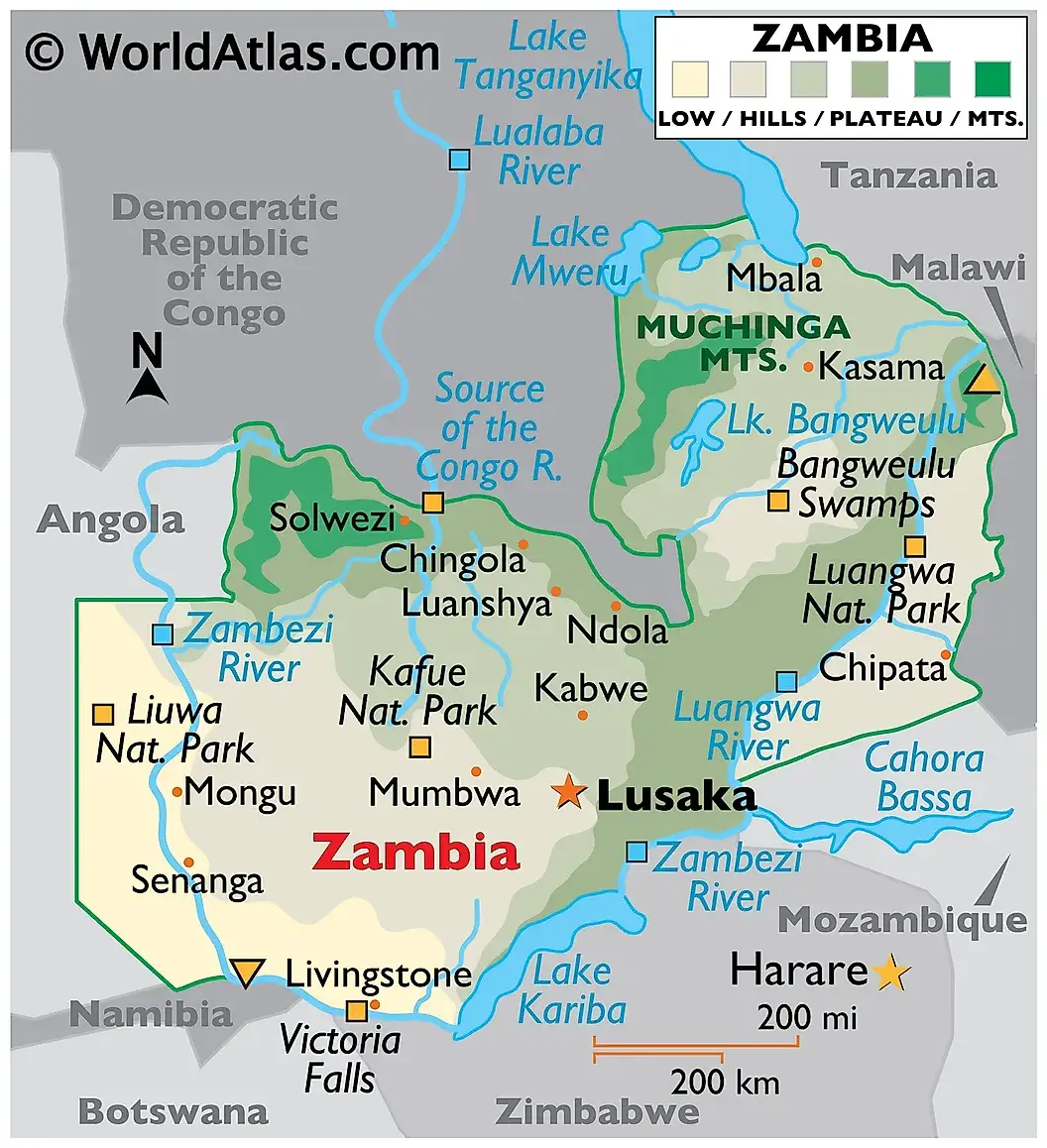The name “Zambia” derives from the Zambezi River, one of the most significant rivers in Africa, which forms part of the country’s southern border. The term “Zambezi” itself likely originates from the word “Dzambé,” meaning “great river” in the languages of the Tonga people, an ethnic group native to the region. The suffix “-ia” is commonly used in place names to signify land or territory, hence Zambia refers to “the land of the Zambezi.”
Before Zambia gained independence in 1964, the country was known as Northern Rhodesia, a name that reflected its colonial status under British rule. The term “Rhodesia” was derived from Cecil Rhodes, a British imperialist who played a significant role in the colonisation of the region. Following independence, the name Zambia was adopted to reflect the country’s new identity.

Zambia is characterised by its varied geography, which includes plateaus, hills, mountains, and several large rivers. The country’s central region is dominated by a high plateau, which rises from the surrounding lowlands to the east and west. The Zambezi River flows along Zambia’s southern border, forming a major natural landmark, while the Congo River system drains the northern region. Notable geographic features also include Lake Tanganyika to the north and Lake Kariba to the south.
The climate of Zambia is generally tropical, with a rainy season from November to April and a dry season from May to October. This climate supports diverse ecosystems, ranging from savannas and grasslands to forests and wetlands, contributing to the country’s rich biodiversity.
Zambia operates as a democratic republic with a multi-party political system. The country is governed under a constitution that provides for a president as the head of state and a multi-chamber legislature. The president is elected through a direct popular vote for a five-year term and has executive authority, including the power to appoint ministers and make key decisions regarding national policy.
Zambia’s political landscape has been dominated by the Patriotic Front (PF), the United Party for National Development (UPND), and the Movement for Multi-party Democracy (MMD). The nation has experienced a tumultuous political history, marked by the transition from one-party rule to a multi-party democracy in the early 1990s.
The recent political landscape has seen increased contestation, particularly in the context of economic challenges, corruption allegations, and concerns about the growing influence of China in Zambia’s development projects. In 2021, Hakainde Hichilema, leader of the UPND, won the presidency, signalling a shift towards policies aimed at economic recovery and anti-corruption reforms.
Zambia’s economy is heavily dependent on mining, particularly copper, which accounts for around 70% of the country’s export earnings. The country is one of the world’s largest producers of copper, and the sector plays a pivotal role in the national economy. However, this dependence on copper has led to vulnerability in the face of global price fluctuations.
Agriculture also plays a significant role, with maize being the staple crop, and other important agricultural products including tobacco, cotton, and sugarcane. Zambia has a growing tourism industry, bolstered by its natural attractions such as the Victoria Falls, one of the Seven Natural Wonders of the World, and its national parks, which host abundant wildlife including elephants, lions, and rhinos.
Despite abundant natural resources, Zambia faces challenges including poverty, high unemployment rates, inflation, and a large informal economy. Additionally, debt levels have risen significantly, leading to concerns about the sustainability of Zambia’s fiscal policies. The government has sought assistance from international institutions such as the International Monetary Fund (IMF) and World Bank to help manage its economic challenges.
Zambia’s population is ethnically diverse, with over 70 different ethnic groups. The largest ethnic group is the Bemba, followed by the Tonga, Chewa, and Lozi. English is the official language and serves as the medium of instruction in schools and government affairs. However, Zambia’s linguistic diversity is reflected in the widespread use of local languages such as Bemba, Nyanja, Tonga, and Lozi, among others.
Zambia’s population is relatively young, with a median age of around 17 years. The country faces challenges related to education, healthcare, and urbanisation. Access to quality healthcare services remains limited, particularly in rural areas, though the government has made efforts to improve healthcare infrastructure. HIV/AIDS has had a significant impact on the demographic profile of the country, though the situation has improved with increased public health initiatives.
Zambian culture is characterised by a rich tapestry of traditions, arts, music, dance, and crafts. Traditional Zambian music, often accompanied by drumming and dancing, forms an integral part of the cultural identity, with genres like Kalindula and Bemba folk music being widely celebrated. Dance is an essential aspect of social gatherings and cultural ceremonies, and many ethnic groups have distinct styles of dance.
Zambian cuisine is varied and largely dependent on maize, with nshima (a starchy, maize-based dish) being the staple food. Meat, fish, and vegetables are also commonly incorporated into dishes, reflecting regional variations in diet.
Religiously, Zambia is predominantly Christian, with a significant proportion of the population adhering to Catholicism, Protestantism, and other Christian denominations. Traditional beliefs are also practiced by a minority of the population, often coexisting alongside Christianity.
Zambia is a member of the Commonwealth of Nations, an organisation primarily consisting of former British colonies and dependencies. Following its independence from the United Kingdom in 1964, Zambia joined the Commonwealth and has since participated in various diplomatic, cultural, and educational exchanges within the organisation. The Commonwealth serves as a platform for Zambia to engage with other member states on issues such as trade, development, and human rights.
Zambia’s membership in the Commonwealth also underscores its historical ties to the British Empire, though the country has sought to establish itself as a sovereign nation in the post-colonial era. Zambia’s commitment to peace and stability in Africa has been recognised within the Commonwealth, particularly in the context of its support for regional initiatives and its stance on human rights.
